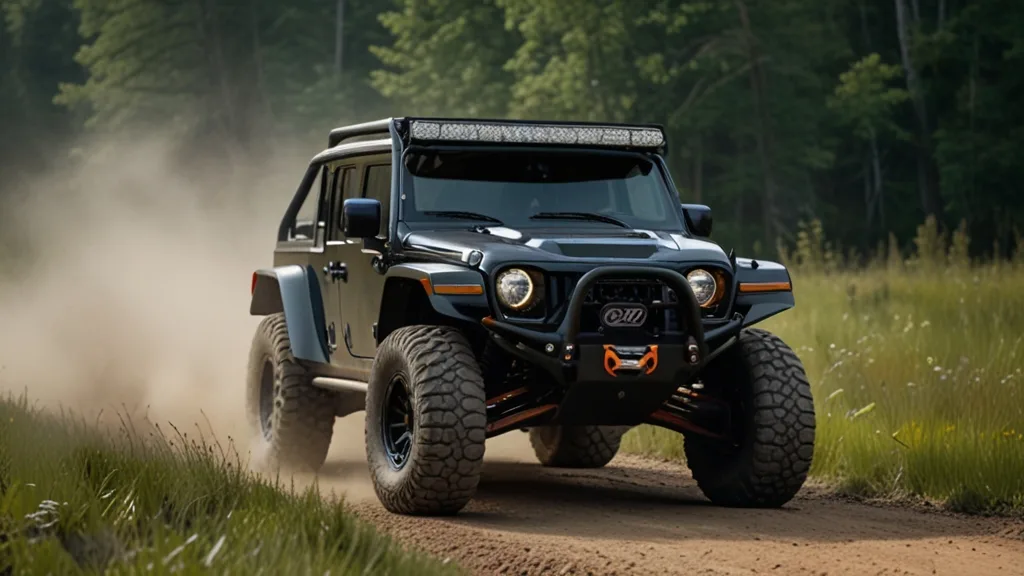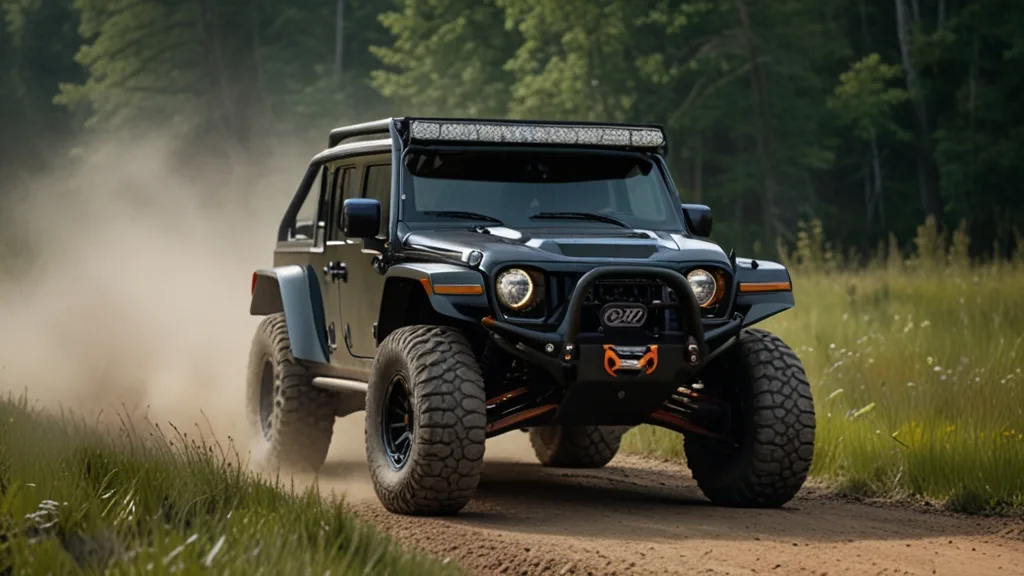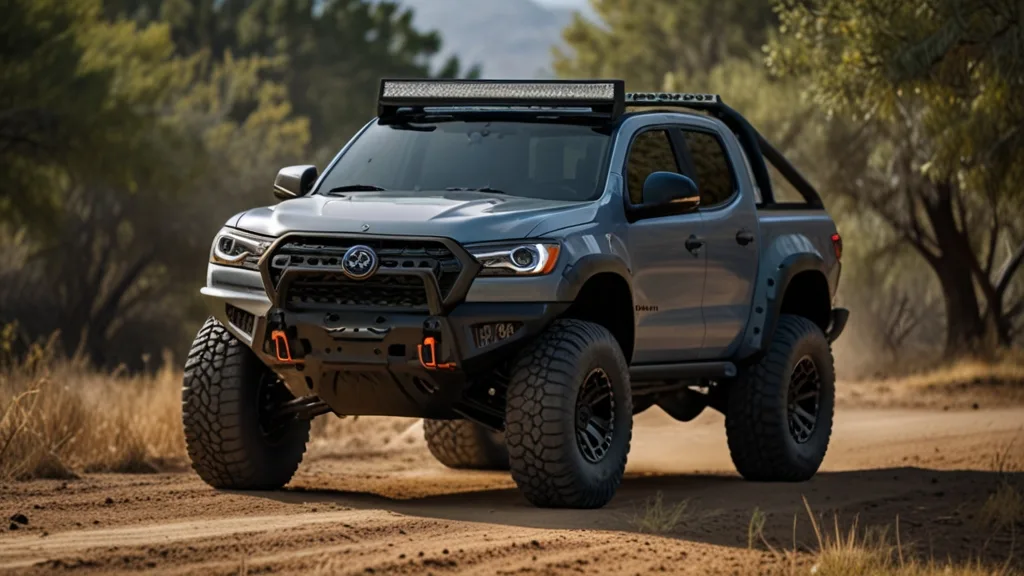How To Build An Off Road Vehicle, start by selecting a robust base model and upgrading the suspension. Equip it with all-terrain tires for improved traction and performance on rough terrain.
Building an off-road vehicle requires meticulous planning and attention to detail. Your journey begins with choosing a durable vehicle that possesses a strong chassis and the potential for modifications. This base is essential for withstanding the rigors of off-road driving.
The next crucial step is enhancing the suspension system; a superior suspension provides the necessary support and flexibility to maneuver through challenging landscapes. All-terrain, high-traction tires are imperative, as they ensure your vehicle maintains grip in mud, sand, or rocky conditions. Upgrading to a powerful engine will give you the extra torque needed for steep inclines and rugged terrain. Protection for vital components comes next, with skid plates and reinforced bumpers. Finally, invest in a winch and recovery gear to ensure you can handle any situation the unpredictable off-road environment throws your way.

Choosing The Right Base Vehicle
Starting the journey toward building an off-road vehicle begins with a critical choice: selecting the right base vehicle. This foundation determines your project’s path, from the complexities of the build to how well it handles the rocky trails. With an eye on the goal, it’s crucial to pick a base that is not just robust but also adaptable to the rugged upgrades and modifications it will undergo.
Considerations For Make And Model
Exploring the available options for an off-road project is exciting. Before settling on a make and model, consider the vehicle’s reputation for durability and ease of modification.
- Durability and reliability top the list.
- Parts availability can make or break your build.
- Community support offers shared knowledge and resources.
Popular choices often include Jeep Wrangler, Toyota Tacoma, and Land Rover Defender. These models boast a proud history of conquering rough terrains. Their widespread use ensures a wealth of aftermarket parts and expertise.
Assessing Your Off-road Needs
Different off-road adventures demand different vehicle attributes. Define your needs to pinpoint the ideal base vehicle.
| Type of Off-Roading | Vehicle Characteristics |
|---|---|
| Rock Crawling | Robust axles, low gear ratios, torque |
| Mudding | Waterproofing, high ground clearance |
| Overlanding | Reliability, storage space, comfort |
Analyze the terrain you plan to tackle. Rock crawlers might lean towards a base with a stout frame and solid axles. Those dreaming of muddy backwoods may prioritize a vehicle with a high air intake and watertight seals. For long-distance overlanding, comfort and fuel efficiency become key. Aligning your needs with the vehicle’s capability is pivotal for a successful off-road build.
Upgrading Tires And Suspension
The first step in off-road conversion is choosing the right tires. All-terrain and mud-terrain tires offer different benefits depending on the landscape.
- All-terrain tires: Balanced for on and off-road driving. Good for a variety of surfaces.
- Mud-terrain tires: Heavy-duty use for muddy, rocky landscapes. Ensure maximum grip and durability.
| Type | Terrain | Features |
|---|---|---|
| All-Terrain | Various | Versatile use, better on-road comfort, moderate off-road performance |
| Mud-Terrain | Muddy/Rocky | Aggressive tread patterns, highest traction off-road, less comfort on-road |
Suspension Modifications For Improved Clearance
Suspension adjustments elevate your vehicle for better clearance and articulation.
- Lift kits: Increase vehicle height, offer space for larger tires
- Upgraded shocks: Enhance articulation, improve ride quality on uneven landscapes
- Adjustable control arms: Fine-tune alignment for optimal performance
Each suspension modification must align with the vehicle’s capabilities. Quality components prevent potential damage during adventures.
Enhancing Engine Performance
Building an off-road vehicle means preparing it to tackle the toughest terrains.
Key to this is enhancing the engine’s performance to deliver raw power and reliable torque.
In this section, we’ll embark on a journey to extract every bit of strength from your off-road warrior’s heart – the engine.
Air Intake And Exhaust Systems
Upgrading your vehicle with high-performance air intake and exhaust systems is a sure-fire way to boost its power.
These systems allow your engine to breathe better, and a well-oxygenated engine is a powerful one.
- Air filters: Go for performance-grade filters to ensure more air gets in with less restriction.
- Cold air intakes: They channel cooler air into the engine, which means denser air for better combustion.
- Exhaust upgrades: A wider exhaust pipe paired with a free-flowing muffler expels gases faster, reducing backpressure.
Tuning For Torque And Horsepower
Once your air intake and exhaust are set, it’s time to fine-tune the engine. Performance tuning can significantly up the torque and horsepower.
| Tuning Aspect | Impact on Vehicle |
|---|---|
| ECU Remapping | Alters fuel delivery and ignition timing for peak performance. |
| Performance Chips | Plug-and-play upgrades that override factory settings for more power. |
| Dyno Tuning | Custom tuning based on real-time data from dynamometer testing. |
Start with these upgrades to see a noticeable difference in performance. Keep in mind each component works in harmony with the others.

Reinforcing The Vehicle Body
Reinforcing the vehicle body is crucial for any off-road machine, ensuring it withstands the harsh terrain and challenges of the wild. The right protection keeps the vehicle’s vital parts safe and gives the driver peace of mind during adventurous rides.
Skid Plates And Roll Cages
Skid plates shield the underbody of your vehicle from rocks and debris. Roll cages protect occupants by maintaining vehicle structure during flips and rolls. Together, they form an essential defense duo.
- Material matters: High-grade steel ensures durability on rugged trails.
- Cover critical areas: Engine, transmission, and fuel tank need the most protection.
- Roll cage designs: Choose a cage that provides maximum coverage without hindering mobility.
Rock Sliders And Bumper Protection
Rock sliders act as a shield for your vehicle’s sides, and bumper protection guards the front and rear. They repel the impact away from the vehicle body.
| Protection Type | Location | Benefits |
|---|---|---|
| Rock Sliders | Sides | Prevent body damage, help in sliding over obstacles |
| Bumpers | Front/Rear | Absorb shocks, offer winch mounting, extra lighting options |
Installing Off-road Accessories
Winches And Recovery Gear
Equipping your vehicle with a robust winch and recovery gear isn’t a luxury, it’s a necessity.
- Choose a winch with a pulling capacity exceeding your vehicle’s weight by at least 50%.
- Attach recovery straps, and D-shackles to handle tough situations.
- Always pack a high-lift jack; crucial for tire changes and underbody repairs.
Lighting And Navigation Systems
Proper lighting and navigation are critical for safe off-road travels.
| Accessory | Function |
|---|---|
| LED Light Bars | Provide broad illumination for night driving. |
| Spotlights | Enable long-distance visibility. |
| GPS Units | Offer precise location tracking. |
Consider a dual battery system to reliably power your accessories.

Essential Off-road Driving Skills
Mastering off-road driving is an adventure. It requires skill and precision.
Boldly take on rugged landscapes. Transform excitement into a smooth ride.
Every off-roader needs vital skills. Let’s gear up and learn!
Navigating Through Different Terrains
- Read the terrain: Stay alert. Look ahead. Avoid surprises.
- Choose the path: Select the best route. Protect your vehicle.
- Be patient: Go slow. Focus on control. Conquer with care.
- Adjust your techniques: Adapt driving style. Match the terrain type.
Understanding Vehicle Dynamics
Knowing your vehicle is crucial.
Tune in to its responses. Grasp how it moves through mud, sand, and rocks.
Discover its limits. Embrace the power. Drive with confidence.
| Terrain Type | Vehicle Response | Driver Action |
|---|---|---|
| Mud | Loss of traction | Maintain momentum |
| Sand | Resistance | Reduce tire pressure |
| Rock | Jarring movements | Use low gears |
Practice makes perfect. Take time to learn. Your off-road journey awaits!
Maintaining Your Off-road Vehicle
When adventure calls, your off-road vehicle answers. But to keep it roaring through rugged terrains, it needs ongoing care. Maintenance ensures reliability on the wildest trails. Skimp on it, and your beast might become a burden.
Routine Check-ups And Repairs
Consistency is key in vehicle care. Regular check-ups prevent surprises on off-road adventures.
- Inspect tires for wear and pressure.
- Check oil levels and quality.
- Examine brakes for responsiveness and wear.
- Ensure suspension components are intact.
- Look at the coolant system to avoid overheating.
Document each check-up. It helps spot issues early.
Customizations And Upkeep For Hardcore Off-roading
Frequent off-roaders demand more. Customizations boost performance but need extra care.
| Custom Part | Maintenance Task |
|---|---|
| Lift Kits | Regular alignment checks |
| Skid Plates | Ensure bolt tightness post-trail runs |
| Winches | Inspect cables and functionality |
| Off-Road Tires | Monitor for cuts, chips, and proper balance |
Upgrade for power, guard against breakdowns. Ignite the joy of off-roading, while keeping maintenance a top priority!
Frequently Asked Questions On How To Build An Off Road Vehicle
How To Make Any Car An Offroad Car?
To make any car an offroad vehicle, upgrade to robust suspension, install all-terrain tires, add protective skid plates, enhance ground clearance, and incorporate a four-wheel-drive system if possible. These modifications provide the necessary durability and traction for rugged landscapes.
Is It Possible To Build Your Own Car From Scratch?
Yes, building your own car from scratch is possible but it requires mechanical knowledge, tools, time, and significant financial resources. You must also ensure legal roadworthiness and registration for your custom vehicle.
Can You Build A TV?
Yes, you can build a UTV by purchasing a kit, using a detailed blueprint, or customizing an existing vehicle with the necessary parts and tools. Ensure you follow safety standards and regulations.
What Makes An Off-road Vehicle?
An off-road vehicle is designed for rugged terrain, featuring high ground clearance, durable tires, and four-wheel drive. It often has a robust suspension and protective underbody features for durability against obstacles.
Conclusion
Building your own off-road vehicle is a challenging yet rewarding venture. It calls for careful planning, the right parts, and a touch of creativity. By following the steps outlined, your journey from garage to wilderness will be a success. Roll out with confidence and conquer the unbeaten path.
Adventure awaits!


